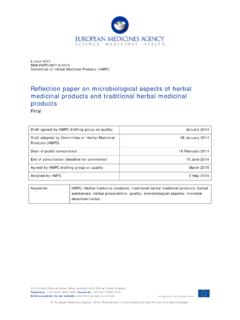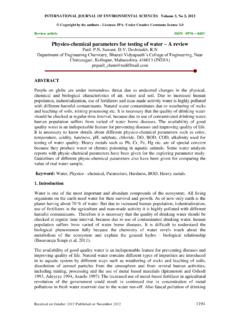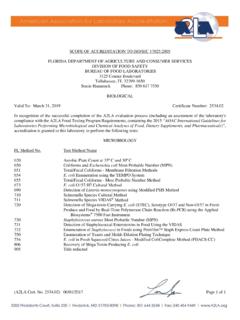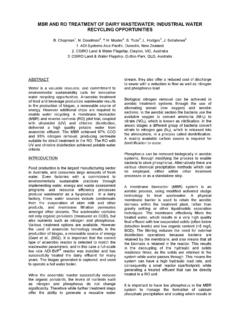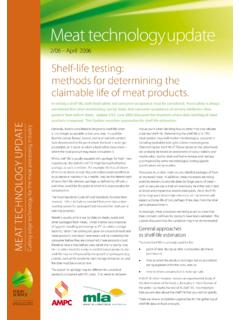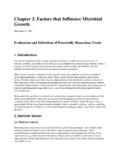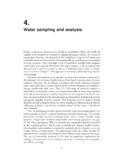Transcription of Tables of Contents - Kroff
1 Tables of Contents General proper+es of water Impuri+es in water Hardness and alkalinity Solubili+es pH and Cycles of concentra+on Cooling water treatment Corrosion and Scale Inhibitors Biocides Opera+on and tes+ng General Properties of Water Some of the proper+es of water which make it ideal for industrial cooling processes are listed below: Water has the capacity to store and transport heat Water absorbs more heat per pound than any other inorganic substance Water has the following physical proper+es: One pound of water gives up 144 BTU's upon freezing At atmospheric pressure, water freezes at 32 deg F and boils at 212 deg F Water is most dense at 40 deg F One pound of water, when transformed into steam, releases 970 BTU's Pure water does not exist in nature General Properties of Water There are two main sources of water, note general di erences Wells and springs are classi ed as ground water sources Low suspended solids and dissolved oxygen, high dissolved solids including iron, hardness, and alkalinity.
2 And also high carbon dioxide Rivers and lakes are classi ed as surface water sources High suspended solids and dissolved oxygen, low dissolved solids including iron, hardness, and alkalinity, and also low carbon dioxide Types of Impurities in Water Suspended solids CATIONS Ca Turbidity Mg K Finely divided suspended or colloidal maWer Na (clay, silt, dirt, organic maWer) Fe, Al, Cu Zn, Si Color ANIONS An arbitrary standard scale used to measure Cl soluble organic materials in water HCO3 CO3 SO4 PO4 NO3 Types of Impurities in Water (cont.)
3 Dissolved solids Dissolved mineral solids When rain falls, it scrubs the atmosphere of carbon dioxide Carbon dioxide mixes with water to form a weak acid called carbonic acid The carbonic acid dissolves mineral solids contained in nature, such as: Limestone (calcium carbonate), dolomite (magnesium carbonate), epsom salt (magnesium sulfate), gypsum (calcium sulfate), sand (silica), and common salt (sodium chloride). Minerals containing sodium have a rela+vely high solubility in water Minerals containing calcium and magnesium have a rela+vely low solubility in water Types of Impurities in Water (cont.)
4 Dissolved Gases Oxygen Corrosive to metal at elevated concentra+ons Solubility in water depends on temperature, surface area and pressure Carbon Dioxide Will form carbonic acid, a weak acid, when dissolved in water Carbonic acid dissociates to form bicarbonate and carbonate alkalinity which is pH dependent Solubility in water depends on temperature, surface area and pressure Types of Impurities in Water (cont.) Miscellaneous Impuri+es Bacteria that require oxygen and produce carbon dioxide are aerobic bacteria Bacteria that do not require oxygen and produce hydrogen sul de are anaerobic bacteria Algae favors exposure to sunlight Fungi favors dark secluded areas Hardness and Alkalinity Hardness (calcium and magnesium) and alkalinity (bicarbonate and carbonate) both play a major role in cooling water treatment.
5 The weak acid, carbonic acid, that is formed during rainfall has the ability to dissolve minerals in the earth's strata The acid solu+on is composed of hydrogen, the posi+vely charged por+on of the solu+on (acidic por+on), and a nega+vely charged counterpart If the earth's strata contains appreciable quan++es of limestone and dolomite, then two of the primary reac+ons between the weak acid and the strata will be with the calcium carbonate and magnesium carbonate Hardness and Alkalinity (cont.) Hardness (calcium and magnesium) and alkalinity (bicarbonate and carbonate) both play a major role in cooling water treatment.
6 As the mineral dissolves, both the calcium and carbonate (as well as the magnesium and carbonate), go into solu+on Once dissolved, both the calcium and magnesium (the posi+vely charged por+ons of the mineral), tend to favor rever+ng back to their natural insoluble state When combined with other mineral impuri+es, calcium and magnesium will preferen+ally precipitate out of solu+on and form an insoluble sludge The reac+on of calcium and magnesium in water with soaps and detergents creates an undesirable sludge which can make laundering di cult.
7 The di culty or hard to wash condi+on led to the the terminology Water Hardness Solubilities The common mineral substances can be CATIONS Ca classi ed into four categories based on Mg solubility: K Na Fe, Al, Cu Calcium and magnesium compounds rules Zn, Si of thumb ANIONS Solubility decreases when temperature rises, Cl alkalinity increases, and available carbon HCO3 CO3 dioxide decreases SO4 BoWom line: hardness salts are more likely to PO4 drop out at high temperatures and pH NO3 Sodium compounds rules of thumb Solubility increases as temperature increases.
8 If deposits with sodium are found, it can generally be aWributed to extreme concentra+ons or evapora+on to dryness BoWom line: Sodium compounds are rarely a problem caused by water treatment) Solubilities (cont.) CATIONS The common mineral substances can be Ca classi ed into four categories based on Mg K solubility (cont.) : Na Fe, Al, Cu Zn, Si Silica dioxide rule of thumb Solubility increases as alkalinity increases ANIONS Cl HCO3 Iron and manganese compounds rule of thumb CO3 Solubility decreases as water alkalinity increases SO4 and as the degree of oxida+on increases PO4 NO3 ( oxygen, chlorine, bromine)
9 PH and Cycles of Concentration De ned exactly, pH is the logarithm of the reciprocal of the hydrogen ion concentra+on in the reac+on A more simple explana+on is that pH is a number between 0 and 14 that denotes various degrees of acidity and alkalinity, with neutral water at pH 7. Below 7 becomes increasingly acidic, while above 7 becomes increasingly alkaline pH and Cycles of Concentration (cont.) pH is a very important parameter in water treatment, especially in cooling water treatment. As water is cycled, alkalinity concentrates, so subsequently pH increases, example: Add heat, lose the Water with 100 ppm volume of water alkalinity through evapora+on Water with 200 ppm alkalinity, pH increase We call this example as being 2 cycles of concentra+on, where mineral concentra+ons, as well as conduc+vity, are doubled At UPMC Shadyside, towers average 5 cycles of concentra+on Langelier Saturation Index (LSI) A numerical value for the scaling poten+al of calcium carbonate (CaCO3) The equa+on is a numerical combina+on of.
10 Total dissolved solids Temperature Calcium hardness Alkalinity pH A posi+ve LSI is scale forming, a nega+ve LSI is corrosive, and zero is perfect equilibrium LSI/RSI Calculation LSI = pH pHs pHs= + TDS[F] + Temp[F] (Ca[F] + Alk[F]) Methods of Treatment for High LSI Acid Feed By reducing pH in cooling water, the equa+on LSI = pH pHs means that LSI will be reduced, therefore calcium carbonate scaling poten+al is reduced Proper dilu+on of acid is cri+cal to contact all points of the system. It is important to equip the system with safeguards if acid feed is lost or ine cient Methods of Treatment for High LSI #2 Organic phosphonates combined with polymers can withstand LSI to + Usually safe to maintain LSI at + Another method of controlling LSI is somened make up, but requires manhours for regenera+on and maintenance Cooling Water Treatment Objec+ve of a cooling water treatment program.

